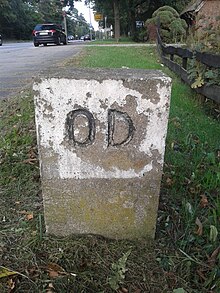Through town
A town passage is a supra- local road or road connection that leads through a place . Federal German road law describes the street section of a federal , state or district road within a town ( city , municipality ) that is intended for internal and external road traffic. There are special conditions for road construction , maintenance and cultivation in this section of town. The beginning and end of the local transit are formally determined by the regional building contractor in consultation with the respective municipality.
Maintenance obligation
The obligations to develop and maintain a road in accordance with traffic needs are the responsibility of the road construction agency. In the case of an inner-city street ( municipal street ), the relevant municipality is responsible for the construction of the road. If, on the other hand, it is a supra-local road and path connection, including through-town traffic, according to the federal system of the Federal Republic of Germany, the road construction agency is usually the federal government (for federal roads), the state (for state roads) or the district (for district roads). A different federal law regulation exists in municipalities with more than 80,000 inhabitants (on federal highways). In this case, the municipality / city bears the road construction load of their through-town. Similar regulations also exist in the road law of the federal states for country and district roads; the population limits differ depending on the federal state, e.g. B. in Baden-Württemberg this is 30,000 inhabitants and in North Rhine-Westphalia 80,000 inhabitants. There are no cultivation restrictions within a through-town , such as on the free stretch of a street.
Demarcation markings

The beginning and end of a local road through town are not determined by the (yellow) entrance signs (these mark the beginning and end of the so-called “closed town”), but by so-called “OD stones”. An OD stone is usually approx. 50 cm high, white or yellow and bears the inscription "OD" (abbreviation for local transit). It can have the shape of a triangular prism or cuboid and also be made as a concrete or plastic "stone"; In some cases the stone is replaced by a sign with the inscription "OD" on a white or yellow background. In some federal German states, the shape of the stone is also cuboid with a semicircular arch on the top. Sometimes the number of the street, the kilometer or a network number is on it. specified (see station symbols ).
The OD stone and the entrance sign are often close together, but do not have to be. In this way, a town passage can begin and end both within and outside of the municipal boundaries.
Exceptions
However, a road through a closed place is not always treated as a through town. The best known in this regard are the motorways and motorways running through the city .
Linking and development areas
In several federal states, the through-roads of certain classified roads are further subdivided into the more cultivation -free connection areas (ODV) and the more cultivated development areas (ODE). From the respective stipulation, for example, the Bavarian Roads and Roads Act will result in the legal consequences for access roads, special uses and the construction prohibited zones. In the instruction road information database (subsystem: network data) the development area is described as follows:
“Area in which properties are developed through driveways or accesses to a street to be included. The legal admissibility follows from the stipulations of a development plan or from the location of the street in an area assessed according to § 34 BBauG. "




